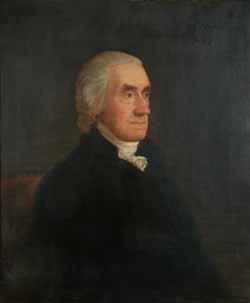The Prosecution’s Closing Argument
John Adams’s closing argument in the trial of soldiers for the Boston Massacre started on 3 Dec 1770 and lasted until the next day.
Then Robert Treat Paine summed up for the prosecution, concluding on the morning of 5 December, 250 years ago today.
Paine’s notes for that presentation survive, though his handwriting is notoriously hard to read. He planned to say:
Edward Pierce’s notes as a juror show that that was just the sort of distinction he was keeping track of. But would he and his fellow jurors accept the Crown’s argument that all the privates were part of an illegal attack on the crowd?
TOMORROW: The judges’ charges and the verdict.
Then Robert Treat Paine summed up for the prosecution, concluding on the morning of 5 December, 250 years ago today.
Paine’s notes for that presentation survive, though his handwriting is notoriously hard to read. He planned to say:
Witnesses tell you they saw nothing of the violent Abuses offered to the Soldiers nor heard the Threats and loud Hallowings testified of by others. Some of this Collection were Boys and Negros drawn there by the Curiosity peculiar to their disposition, and without doubt might throw some Snow Balls, and its quite natural to believe from the Evidence and the Nature of the thing that there were some there armed with Sticks and Clubbs determin’d if the Soldiers abused them in the manner they had the Inhabitants that Evning and at times before to try the weight of them and had repaired into K[ing].S[treet]. on a Supposition that those Soldiers who had began the disorder of the Evening at a time when they ought to have been in their Barracks were continuing their disorders there, (for it appears about the time of the attack on the Centry [several?] partys of Soldiers were seen in K.S. armed with clubbs Cutlasses &c.;) and that they had not the least design or Idea of Attacking a Party on duty. And many other peaceable people gathered there meerly to see what was going on.Paine singled outs Pvts. Montgomery and Kilroy as killing specific victims. Since the corporal was “pretty certain” not to have fired a shot, Paine argued the other privates just must have shot the rest.
Can any person living from the history of this Affair as it turns up in Evidence Suppose these persons were such dangerous rioters as to bring them within those Rules of Law which have been read to you that it is lawful to kill them; Shall the innocent and peaceable who by meer Casualty are mixt with [some?] of the ruder Sort be liable to be Shot down by a Party of Soldiers meerly because they please to call ’em dangerous Rioters? Tis the Action [Generally?] and not a few [Angry?] tho threatning Expressions that constitutes any Riot and the Agreement of the whole Body that makes ’em Partys. This appears from some of the Authoritys read. . . .
It is proved to you Gentlemen that all the Prisoners at the Bar were present in K.S. at the firing. It appears by the current of the testimony that 7 Guns were fired, and it appears pretty certain that [William] Wemys, the Corporal was the one who did not fire. It is certain that five men were killed by the firing of which [Edward] Montgomery killed [Crispus] Attucks and [Mathew] Kilroy killed [Samuel] Grey.
But which of the other 5 prisoners killed the other 3 of the deceased appears very uncertain. But this operates nothing in their favour if it appears to you that they were an unlawful Assembly for it has been abundantly proved to you by the Numerous Authoritys produced by the Council for the Prisoners, that every individual of an Unlawful Assembly is answerable for the doings of the rest. They are all considered as Principals, and all that are present aiding assisting and abetting to the doing an unlawful act as is charged in the Several Indictments against the Prisoners are also considered as Principals. . . .
When you recollect further, the Account given you by many Witnesses, that on firing the first Gun the people dispersed and were in a Manner withdrawn to a distance at the firing the last Guns[;] that the last Gun was fired at a Boy at a distance running down Street; that they presented their firelocks again at the few people who came with the Chirugeon [Dr. Joseph Gardner] to pick up the Dead it appears to me you must be Satisfy’d they were possessed of that Wicked depraved malignant Spirit which constitutes Malice, that from the whole Evidence taken together no just Cause appears for such outrageous Conduct and therefore that they must be considered as aiding and assisting each other in this unlawful Act which the lawfulness of their Assembling will not excuse. . .
Edward Pierce’s notes as a juror show that that was just the sort of distinction he was keeping track of. But would he and his fellow jurors accept the Crown’s argument that all the privates were part of an illegal attack on the crowd?
TOMORROW: The judges’ charges and the verdict.


No comments:
Post a Comment